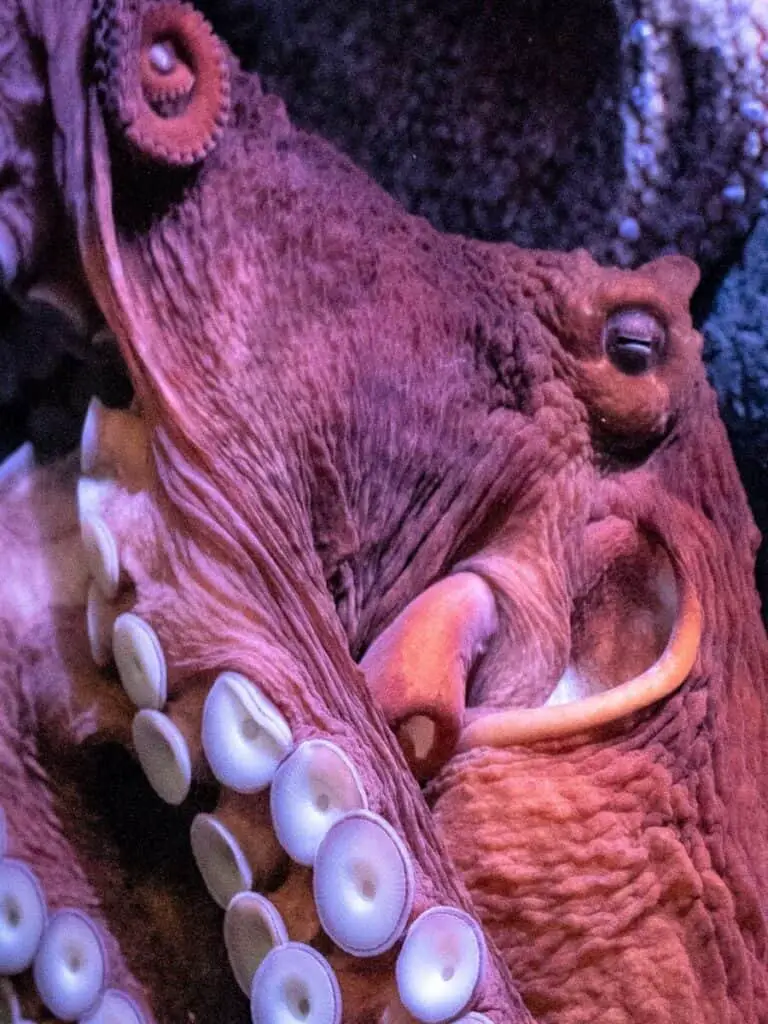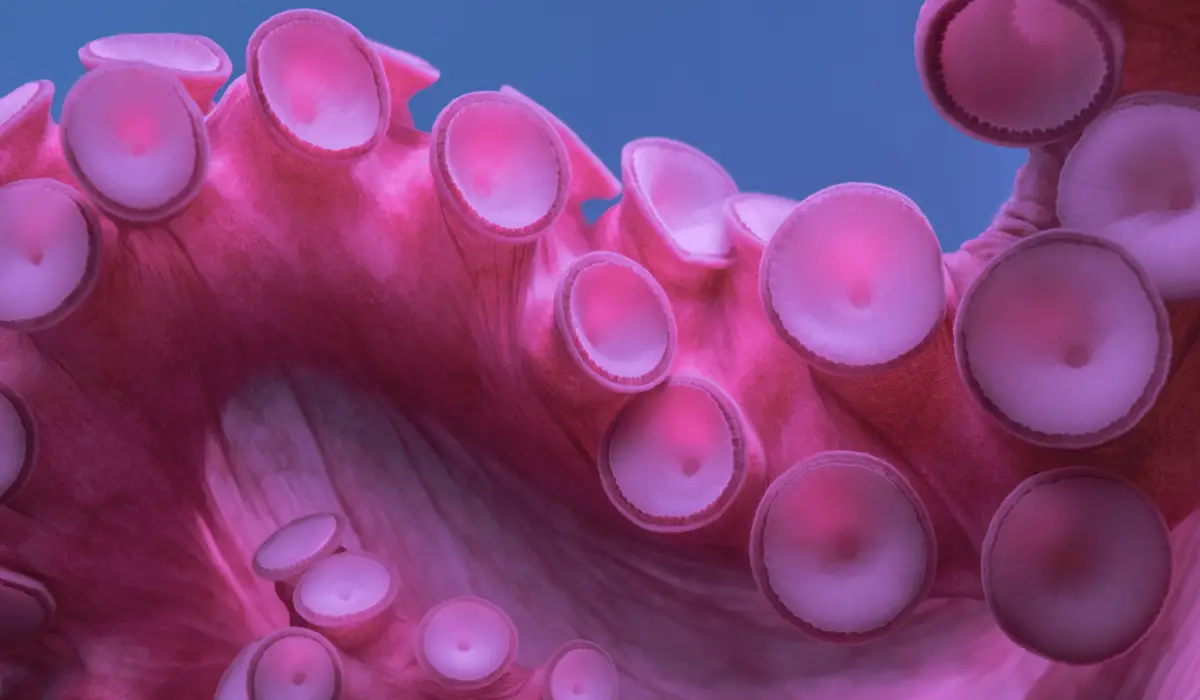Here are the top 10 fascinating facts about octopus suckers:
- Octopus suckers are used for gripping and manipulating objects, but they can also be used for taste and smell.
- Octopus suckers can move and grasp objects independently.
- Octopus suckers can form a seal on rough surfaces underwater.
- Octopus suckers are used to pry open and obliterate clams, crabs, and other sea life that would be hard to eat under normal circumstances.
- Each one of the Giant Pacific Octopus’s larger suckers, near the beak and mouth, can hold up to 35 pounds! Imagine the combined strength of several suckers.
- Octopus suckers have tiny hairs that help them stick to surfaces.
- Octopus suckers can taste the water around them.
- Octopus suckers can create a pressure difference of up to 0.269 megapascals to keep a sucker suctioned, which is equivalent to 2,690 kilopascals (kPa). As a point of reference, a typical vacuum cleaner has a suction power of around 20-30 kPa.
- If one of an octopus’s suckers finds something interesting, like food, it triggers a sucker next to it to double check.
What Makes Octopus Suckers So Unique?
Octopus suckers are some of the most fascinating and versatile tools in the animal kingdom. They allow the octopus to catch prey, avoid predators, and manipulate its environment in ways that are truly remarkable. Whether you’re a scientist, a diver, or just a curious observer, there’s no denying the incredible power and adaptability of the octopus and its suckers.
One of the most impressive examples of the power of octopus suckers, is the ability of the Giant Pacific Octopus to open jars and containers. In laboratory experiments, researchers have shown that these octopuses can easily twist off the lids of jars and even unscrew the caps of child-proof medicine bottles. This is a remarkable feat of strength and dexterity, considering that octopuses have no bones and are made almost entirely of soft tissue. Also see my article on octopus intelligence.

How many suckers does an octopus have
An octopus can have hundreds of suckers on each arm, depending on the species. For example, the Giant Pacific Octopus can have up to 280 suckers on each arm.
On average, an octopus can have around 200 to 300 suckers on each arm, which means that a typical octopus can have around 1,600 to 2,400 suckers in total.
Fascinating Details About Octopus Suckers
Octopuses are some of the most fascinating creatures in the ocean, and their suckers are no exception.
Octopus Suckers as Multi-Purpose Tools
Octopus suckers are not just used for gripping and manipulating objects, but they can also be used for taste and smell. This means that the suckers can help the octopus find food, avoid predators, and navigate its environment.
Independent Movement of Octopus Suckers
Octopus suckers can move and grasp objects independently, which allows the octopus to manipulate multiple objects at once. This is an important adaptation for an animal that needs to be able to catch prey, avoid predators, and manipulate its environment.
Octopus Suckers’ Ability to Form Seals on Rough Surfaces
Octopus suckers are able to form a seal on rough surfaces underwater, which allows the octopus to hold onto objects more securely. This is an important adaptation for an animal that needs to be able to hold onto prey, avoid predators, and navigate its environment.
Octopus Suckers’ Role in Feeding
Octopus suckers are used to pry open and obliterate clams, crabs, and other sea life that would be hard to eat under normal circumstances. This allows the octopus to access food that would otherwise be inaccessible, and helps it to survive in its environment.
See my article How Do Octopus Kill Their Prey? Can an Octopus Sting You? (Beaks and Venom)
The Power of Giant Pacific Octopus Suckers

The Giant Pacific Octopus’s larger suckers, near the beak and mouth, can hold up to 35 pounds! This is an incredible feat of strength, and allows the octopus to catch and hold onto larger prey.
Tiny Hairs on Octopus Suckers
Octopus suckers have tiny hairs that help them stick to surfaces. These hairs are called setae, and they help the suckers to grip onto surfaces more securely. They form a spiral arrangement that creates a “groove” and allows the sucker to form a stronger seal and hold onto objects with greater force.
Octopus Suckers’ Ability to Taste the Water
Octopus suckers can taste the water around them, which allows the octopus to detect prey, avoid predators, and navigate its environment. This is an important adaptation for an animal that needs to be able to find food and avoid danger.
The Pressure Difference of Octopus Suckers
Octopus suckers can create a pressure difference of up to 0.269 megapascals to keep a sucker suctioned. This is an incredible feat of engineering, and allows the octopus to hold onto objects more securely. This is equivalent to 2,690 kilopascals (kPa). When you consider that a typical vacuum cleaner has a suction power of around 20-30 kPa, this amount of suction would be painful if an octopus really wanted to grab onto your arm.
Octopus Suckers Work Together
If one of an octopus’s suckers finds something interesting, like food, it triggers a sucker next to it to double check. This collaborative behavior allows the octopus to work together to find food, avoid predators, and navigate its environment.
The Evolution of Octopus Suckers
The Origins of Octopus Suckers
Octopus suckers have been around for millions of years, evolving from simple adhesive pads found in their ancestors. These pads, found in animals like snails and slugs, were used for locomotion and adhering to surfaces.
Over millions of years, octopuses developed more complex suckers that could be used for gripping, manipulating, and even feeding.
The Development of Octopus Suckers
The development of octopus suckers is a fascinating process. In the embryonic stage, octopuses start out with simple bumps on their arms that eventually develop into suckers. As they grow, the suckers become more complex, with muscles, nerves, and sensory cells.
By the time they are fully developed, an octopus can have hundreds of suckers on each arm, each one capable of independent movement and manipulation.
Another interesting fact: male octopuses have a special arm for reproduction that is longer than the others, complete with erectile tissue. See my article How do Octopus Reproduce? (Cannibalistic Sex and a Detachable Member)
Interestingly, if an octopus loses one of its arms, it can regenerate a perfect replacement complete with all the suckers and nerves in approximately 100 days. See my article Can Octopus Arms Grow Back? (Are Regenerated Limbs Just as Good?)
The Adaptive Significance of Octopus Suckers
Octopus suckers have played a crucial role in the survival and success of these intelligent creatures. They allow octopuses to grip and manipulate objects with incredible dexterity, making them skilled hunters and problem solvers. The ability to taste and smell with their suckers also helps them locate and identify prey in their environment.
Additionally, the ability to create a seal on rough surfaces allows them to move quickly and efficiently through their underwater world.
Overall, the evolution of octopus suckers is a remarkable example of how complex structures can develop over time to meet the needs of a species. From simple adhesive pads to complex, multi-functional suckers, these structures have helped octopuses thrive in their environment and become one of the most fascinating creatures in the ocean.
Octopuses are, in fact, the most intelligent invertebrates in the world and one of the most intelligent creatures in the oceans. See my article How Smart are Octopuses? (Are Octopuses As Intelligent as Dogs?)
The Future of Octopus Suckers
The Potential Applications of Octopus Suckers
Octopus suckers have been the subject of research for a long time, and scientists believe that they have a lot of potential applications in various fields. For example, the medical industry could use octopus sucker-inspired technology to create better surgical tools that can grip and manipulate delicate tissues without causing damage. Similarly, the robotics industry could use octopus sucker-inspired technology to create better gripping mechanisms for robots that need to handle fragile objects.
The Challenges of Studying Octopus Suckers
Despite the potential applications of octopus suckers, studying them is not an easy task. One of the main challenges is that octopuses are intelligent and curious animals that do not like to be confined. This makes it difficult to study their suckers in a laboratory setting.
Additionally, octopus suckers are incredibly complex structures that are difficult to replicate in a laboratory setting. As a result, researchers must rely on observing octopuses in their natural habitats to learn more about their suckers.
The Importance of Preserving Octopus Habitats
Finally, it is important to note that the future of octopus suckers is closely tied to the future of octopus habitats. Octopuses are incredibly sensitive to changes in their environment, and even small alterations in water temperature or acidity can have a significant impact on their health and well-being.
As such, it is crucial that we take steps to preserve octopus habitats and ensure that these fascinating creatures continue to thrive. In conclusion, octopus suckers are incredibly fascinating structures that have a lot of potential applications in various fields.
However, studying them is not an easy task, and their future is closely tied to the future of their habitats. By taking steps to preserve octopus habitats and continuing to study these amazing creatures, we can unlock even more secrets about the incredible world of the octopus.
References:
- Octopus suckers are used for gripping and manipulating objects, but they can also be used for taste and smell. (source: National Geographic)
- Octopus suckers can move and grasp objects independently. (source: Scientific American Blog Network)
- Octopus suckers can form a seal on rough surfaces underwater. (source: Scientific American Blog Network)
- Octopus suckers are used to pry open and obliterate clams, crabs, and other sea life that would be hard to eat under normal circumstances. (source: OctoNation)
- The Giant Pacific Octopus’s larger suckers, near the beak and mouth, can hold up to 35 pounds! (source: OctoNation)
- Octopus suckers have tiny hairs that help them stick to surfaces. (source: Scientific American Blog Network)
- Octopus suckers can taste the water around them. (source: Scientific American Blog Network)
- Octopus suckers can create a pressure difference of up to 0.269 megapascals to keep a sucker suctioned. (source: Scientific American Blog Network)
- If one of an octopus’s suckers finds something interesting, like food, it triggers a sucker next to it to double check. (source: [NOVA | PBS](https://www.pbs.org/wgbh/nova


